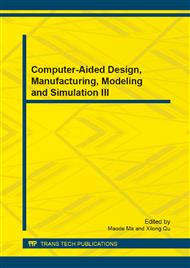[1]
YANG Changhao . Intelligent Method Research for Fault Diagnosis of Mechanism Based on Uncertainty Theory[D]. University of Science and Tehnology of China, (2008).
Google Scholar
[2]
CHEN Peilin; SHI Tielin , et al. A Problem-Solving Strategy for Distributed Fault Diagnostic Expert System on a Large Mechanic-Electric Equipment [J]. China Mechanical Engineering, 1995, 6(3): 20-23.
Google Scholar
[3]
TIAN Shuwu. Research of Failure Diagnosis Based on Case-Based Reasoning in Extended Manufacturing Quality Management [D]. Nanjing University of Aeronautics and Astronautics, (2008).
Google Scholar
[4]
Wang zhongjun. Research on Construction and Key Technology of Intelligent Freeway Management Platform Based on GIS [D]. The Information Engineering University for The PLA, (2009).
Google Scholar
[5]
WANG Qingfeng, YANG Jianfeng, LIU Wenbin , et al. Development and Application of Process Industry Equipment Maintenance Information System for Intelligent Decision-making [J]. Chinese Journal of Mechanical Engineering, 2010, 46(24): 168-177.
DOI: 10.3901/jme.2010.24.168
Google Scholar
[6]
FENG Zhipeng. Application of Computational Intelligence to Fault Diagnosis of Machinery [D]. Dalian University of Technology, (2003).
Google Scholar
[7]
ZHAO Ming. The Locomotive Fault Diagnosis Expert System of Case-based Reasoning [D]. The Central South University, 2004, 4.
Google Scholar
[8]
Pawlak Z. Drawing conclusions from data-the rough set way[J]. International Journal of Intelligent Systems. 2001, 16: 3–11.
DOI: 10.1002/1098-111x(200101)16:1<3::aid-int2>3.0.co;2-i
Google Scholar
[9]
YAO Yiyu, ZHAO Yan. Attribute reduction in decision-theoretic rough set models[J]. Information Sciences, 2008, 178(17): 3356-3373.
DOI: 10.1016/j.ins.2008.05.010
Google Scholar
[10]
LI Huaxiong, ZHOU Xianzhong, ZHAO Jiabao, et al. Attribute reduction in decision-theoretic rough set model: a further investigation[C]. Proceedings of the 6th International Conference on Rough Sets and Knowledge Technology, (2011).
DOI: 10.1007/978-3-642-24425-4_61
Google Scholar
[11]
Slezak D. Approximate entropy reducts[J]. Fundamenta Informaticae, 2002, 53(3, 4): 365-390.
Google Scholar
[12]
WANG Guoyin. Calculation Methods for Core Attributes of Decision Table [J]. Chinese Journal of Computers, 2003, 26(5): 611-615.
Google Scholar
[13]
LIANG Jiye, XU Zongben. The Algorithm on Konwledge Reduction in Incomplete Information Systems[J]. International of Uncertainty, Fuzziness and Knowledge-Based System, 2002, 24(1): 95-103.
DOI: 10.1142/s021848850200134x
Google Scholar
[14]
Slezak D. Attribute reduction in the Bayesian version of variable precision rough set model[J]. Electronic Notes in Theoretical Computer Science, 2003, 82(4): 1-11.
DOI: 10.1016/s1571-0661(04)80724-2
Google Scholar
[15]
YAO Yiyu. Probabilistic approaches to rough sets. Expert Systems, 2003, 20(5): 287-297.
DOI: 10.1111/1468-0394.00253
Google Scholar
[16]
Pawlak Z. Rough Sets: Theoretical aspects of reasoning about data[M]. Boston, Kluwer Academic Publishers, (1991).
Google Scholar
[17]
Pawlak Z. Rough Sets and intelligent data analysis[J]. Information sciences, 2002, 147: 1-12.
Google Scholar
[18]
HU Qinghua, YU Daren, XIE Zongxia. Numerical Attribute Reduction Based on Neighborhood Granulation and Rough Approximation [J]. Journal of Software, 2008, 19(3): 640-649.
DOI: 10.3724/sp.j.1001.2008.00640
Google Scholar
[19]
SHAO Fengjing, YU Zhongqing. Principle and Algorithm of Data Mining[M]. China WaterPower Press, 2003. 8.
Google Scholar


